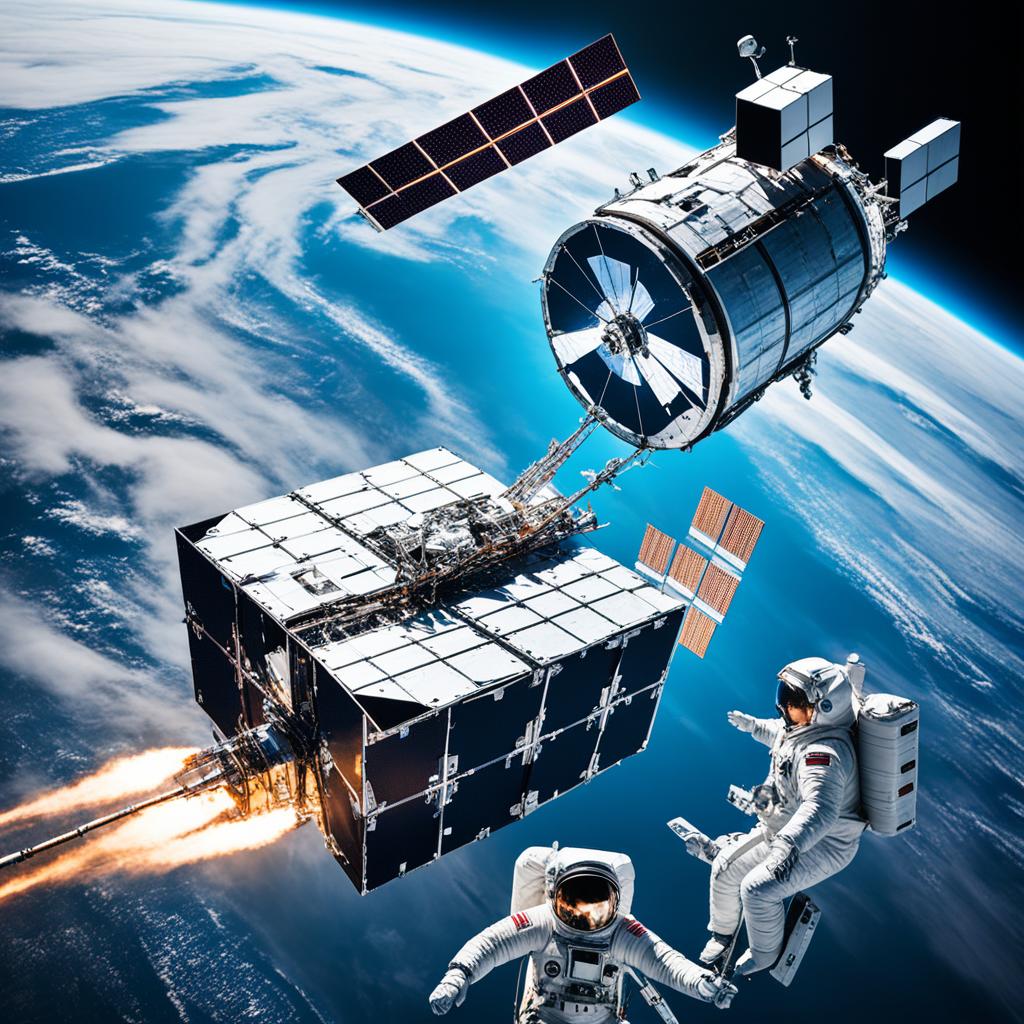Advertisements
Researchers from the United Kingdom have developed the STRaND-1 nano-satellite, controlled by a smartphone. The aim of the project is to demonstrate advances in the rapid and affordable construction of satellites. The nano-satellite weighs just 4kg and will be launched into orbit later this year. The team used smartphones because of their components, such as sensors, cameras, GPS and Wi-Fi communication systems, which are efficient and cheaper than those used in conventional satellites. Furthermore, smartphones are lighter. Tests are being carried out to ensure that the device withstands space conditions, and if successful, the smartphone will be used to operate parts of the satellite.
Main points of this article:
- Smartphones are being used in the development of nano-satellites to demonstrate advances in space technology
- Smartphone components, such as sensors and communication systems, are efficient and cheaper than those used in conventional satellites
- Tests are being carried out to ensure the ability of smartphones to withstand space conditions
What is satellite communication for cell phones?
A satellite communication for cell phones is an innovative method that uses space technology to allow cell phones to connect to telephone networks even in remote areas or without land cover. It's like having a sign cell phone global, reaching places where conventional mobile service is not available.
Advertisements
This technology uses satellites in orbit around the Earth to transmit signals cell phone. These satellites emit electromagnetic waves that enable communication between cell phones and telephone networks. There are two main types of satellites used in this method: geostationary and non-geostationary.
Geostationary satellites remain in a fixed position in space, aligned with a certain geographic area. They are ideal for providing comprehensive and stable coverage, as they do not move in relation to the Earth's surface. Non-geostationary satellites are constantly moving around the Earth, providing coverage in different areas over time.
Advertisements
A satellite communication for cell phones allows users to make calls, exchange messages and access the internet even in remote locations, such as deserts, mountains, ocean and rural areas. Furthermore, this technology is essential in emergency situations, such as natural disasters, where communication is crucial to saving lives.
A satellite communication for mobile phones is a giant leap in global connectivity. Now, we can communicate virtually anywhere, at any time. It's a revolution for mobile communication.
With satellite communication, it becomes possible to overcome geographic barriers and promote digital inclusion, connecting people around the world. It's a technology that is transforming the way we communicate and providing unlimited opportunities for contact, regardless of location.
| Benefits | Disadvantages |
|---|---|
| Access to communication in remote areas | Cost highest initial |
| Guarantee of communication in emergency situations | Lower internet and data speed |
| Global coverage | Legal restrictions and regulations |
Satellite communication for cell phones has the potential to continue evolving and improving in the future. As more companies invest in this technology, costs can decrease and service quality can improve. This will open doors to greater intergalactic connectivity, transforming the way we communicate and connect globally.
How does satellite communication for cell phones work?
To understand how it works satellite communication for cell phones, it is important to understand the infrastructure behind this system. Satellite communications technology for cell phones relies on a network of satellites in orbit around the Earth, which emit electromagnetic waves to ensure connectivity in remote or low-frequency areas. land cover.
See too:
When a user makes a call or sends a text message using a cell phone satellite compatible, the device sends a signal to the nearest satellite. The satellite then retransmits this signal, transmitting the waves to the destination cell phone. This is how complete and comprehensive communication is established, allowing voice calls, text messaging and internet access.
And speaking of access to the internet, satellite communication also guarantees access to the global network even in remote areas or with little access. land cover. This is because satellites can provide high-speed internet service, allowing users to access and browse the web even in locations where conventional mobile service is not available.
Furthermore, satellite communication technology is also used in emergency situations. When an accident occurs or there is a need to call for help in a remote area, users can make emergency calls and send messages to emergency services via satellites in orbit around the Earth. This communication ability saves lives at critical moments.
Benefits of satellite communication for cell phones:
- Connectivity in remote areas or with little terrestrial coverage
- High-speed internet access anywhere
- Ability to make calls and send emergency messages
Challenges of satellite communication for cell phones:
- Dependence on open skies or a clear view of the sky to receive and transmit the signal
- Cost highest starting price of satellite-compatible mobile devices
- Cost of satellite communication service may be higher than conventional services
- Internet and data speeds may be lower than conventional operators
- Regulation and legal restrictions can limit market entry
Despite challenges, satellite communication for cell phones has been increasingly adopted and improved by large companies, aiming to improve signal coverage and connectivity around the world. The future of this technology promises significant advances, allowing more people to communicate and have access to the internet, regardless of geographic location.
| Benefits | Challenges |
|---|---|
| Connectivity in remote areas | Open-air dependency |
| High speed internet access | High initial cost |
| Emergency communication | Service cost |

How can satellite communication for cell phones be used?
Satellite communication for cell phones has numerous applications, providing benefits in different situations and scenarios. One of the main advantages is the ability to allow communication in emergency situations, where conventional connection may be unavailable or limited.
In cases of health problems or accidents in remote areas or without terrestrial coverage, users can rely on satellite communication to call for help, send alerts and maintain contact with emergency services. This technology can be a real lifesaver at critical moments, ensuring that assistance and support are provided quickly.
In addition to emergency situations, satellite communication for cell phones is also extremely useful for people who live or work in places with difficult access to conventional telephone services. In rural areas, remote regions or regions with weak signal, this technology offers a reliable and efficient alternative for maintaining communication, whether for personal or professional use.
Large companies, such as Apple and Samsung, are aware of the potential of satellite communication and are already developing smartphones with this technology integrated. These devices make it possible to improve communication and send alerts in emergency situations, further expanding the usefulness of this resource for users.

Satellite communication for cell phones is increasingly present in our lives, offering effective and reliable solutions for various situations. Whether in times of emergency or in everyday life, this technology has the power to connect people and ensure communication anywhere in the world.
What are the main challenges of satellite communication for cell phones?
Satellite communication for cell phones faces several challenges that need to be overcome to ensure an efficient and reliable experience. In this section, we will explore the main obstacles this technology faces.
Ground Coverage
One of the challenges The most significant aspect of satellite communication for cell phones is the need for broad terrestrial coverage. This technology requires a clear view of the sky or open sky to send and receive signals. In densely populated areas, such as urban centers, forests or mountainous regions, land coverage may be compromised due to physical obstacles. This can result in dropped calls, slow or unstable connection, and difficulty establishing effective communication.
Cost
Another challenge faced by satellite communication for cell phones is cost. Mobile devices compatible with this technology tend to be more expensive than conventional smartphones. Furthermore, the cost of satellite communication service is generally high, making it less accessible to a large number of users. This financial barrier may limit the widespread adoption of this technology, especially in regions with lower purchasing power.
Speed and Data Limitations
The internet speed and the amount of data available in satellite communication for cell phones are generally lower than those offered by conventional operators. This can result in slow connections, slow downloads, and poor-quality media streaming. These limitations may negatively impact the user experience and restrict the use of certain applications or services that require a high-speed connection.
Regulation and Legal Restrictions
Entry into the satellite communications market for cell phones is subject to varying regulations and legal restrictions. Depending on the country, there may be specific requirements regarding the frequencies and licenses needed to operate satellite communications services. These regulations can vary significantly and create challenges for companies wanting to offer this technology globally.
Although satellite communication for cell phones faces significant challenges, the industry is constantly working to overcome them and improve the technology. Expanding terrestrial coverage, reducing costs, increasing internet speeds and improving regulation can drive the advancement of this form of communication, making it more accessible and efficient for users.
What to expect from satellite communication for cell phones in the future?
Satellite communication for cell phones has a promising future, full of technological advances and fascinating possibilities. Large companies such as Apple and Samsung are investing in satellite communications technology, driving development and innovation in this field. With constant progress in this area, we can expect several improvements and benefits for users.
Fierce competition between companies
In the future, increasing competition among companies developing satellite communications technology is expected to result in significant advances. As more companies enter this market, there will be an increase in the supply of devices and services, which can lead to more competitive and affordable prices for consumers. This means that satellite communication for cell phones could become more accessible to an increasing number of people.
Improvement in the quality and coverage of mobile networks
One of the main advantages of satellite communication for cell phones is the ability to provide coverage in remote areas with little terrestrial coverage. In the future, thanks to technological advances, we can expect a significant improvement in the quality and coverage of mobile networks. Companies like SpaceX are developing projects to launch constellations of low-orbit satellites around the world, which have the potential to provide exceptional coverage and fast, reliable connections virtually anywhere.
Imagine being able to make calls, send messages and access the internet in remote locations, such as isolated islands, mountainous regions or rural areas, where conventional telephone service is limited or non-existent. Satellite communication for cell phones can bring a true revolution in the way we communicate and access information, enabling unprecedented global connectivity.
The future of satellite communication for cell phones
Satellite communication for cell phones is constantly evolving. The speed at which technology is advancing is impressive and brings hope of a intergalactic connectivity. In the future, we can expect the integration of new technologies, such as artificial intelligence and the internet of things, into satellite communication. This will open doors to a multitude of possibilities and applications innovative.
Furthermore, satellite communication for cell phones can play a crucial role in emergency situations, providing communication at critical times when other means of communication may fail. The potential of this technology is vast and goes beyond imagination. We are just scratching the surface of what is possible to achieve.
O future of satellite communication for mobile is exciting and full of potential. As technology develops and advances, we can expect a significant improvement in the quality and coverage of mobile networks, as well as greater accessibility and functionality for users. Satellite communication for cell phones is opening new horizons and shaping the future of communication.
What does SpaceX plan with Starlink?
A SpaceX, Elon Musk's company, is ready to revolutionize the satellite communications sector with its ambitious project called Starlink. In 2023, the company intends to start testing its satellite cell service, which promises to bring high-speed connectivity to remote locations and improve internet quality globally.
A Starlink it will be made up of a constellation of low-orbit satellites, which will provide cellular coverage around the world. A SpaceX has already established strategic partnerships, including one with T-Mobile, to offer mobile phone services through T-Mobile's satellites. Starlink, aiming to eliminate areas without land coverage.
This initiative represents a revolution in the way people communicate. Imagine being able to make a call, send messages or access the internet in remote locations, without relying on terrestrial antennas or conventional telecommunications infrastructure. SpaceX is working to make this a reality, and soon we will be able to enjoy a intergalactic connectivity.
“We are entering a new era of communication, in which global connectivity becomes a reality. With Starlink, we are taking the internet where it has never gone before, providing opportunities and improving the lives of people around the world.” – Elon Musk
The future of satellite communication
With SpaceX's innovative vision and ongoing technological advancements, we can look forward to a promising future for cell phone satellite communications. In addition to providing mobile phone services, Starlink has the potential to revolutionize the internet industry by providing a stable, high-speed connection in rural, remote and underserved areas.
That technological development It will also open up new possibilities in other areas, such as telemedicine, distance education and access to real-time information. Global connectivity will become essential for the digital economy and social progress.
| Advantages of Starlink | Challenges to be overcome |
|---|---|
|
|
SpaceX is leading the way to a connected future, and we look forward to seeing the results from this visionary company. Starlink has the potential to take satellite communication to the next level and revolutionize the way we communicate on a global scale.
Conclusion
O advancement of space technology and the use of smartphones in space They are transforming the way we communicate interplanetarily. Nanosatellites controlled by smartphones are an innovation that is making space technology more accessible and opening doors to a greater number of people. Furthermore, satellite communication for cell phones makes it possible to break down barriers in remote areas without terrestrial coverage, offering intergalactic connectivity.
While we still face challenges regarding coverage, cost and regulation, it is encouraging to note that companies are investing heavily in developing this technology. O future of satellite communication for cell phones is promising, with technological advances that will further boost global connectivity. We can expect a significant improvement in communication across the world, allowing people from different regions to access intergalactic connectivity.
O advancement of space technology and from satellite communication to cell phones is an important step towards expanding the limits of connectivity. This technological revolution allows us to explore new horizons and reach regions of the planet and space that were previously inaccessible. As we continue to advance, it is safe to say that intergalactic connectivity will become an ever closer reality, providing a new era of communication and discovery.
FAQ
What is satellite communication for cell phones?
Cellphone satellite communication is a method that uses satellites in orbit around the Earth to transmit cellular signals and allow users to connect to telephone networks even in remote areas or without terrestrial coverage.
How does satellite communication for cell phones work?
To work, there must be a network of satellites in orbit around the Earth that emit electromagnetic waves to communicate with compatible cell phones. When a user makes a call, the cell phone sends a signal to the satellite, which transmits the waves to the destination cell phone, allowing complete and comprehensive communication.
How can satellite communication for cell phones be used?
Satellite communication for cell phones has several applications. In emergency situations, such as health problems or accidents, users can ask for help even in remote areas or without land coverage. The technology is also useful for people who live or work in places with difficult access to conventional telephone services, such as rural areas or regions with weak signal.
What are the main challenges of satellite communication for cell phones?
Satellite communication for cell phones faces challenges in terms of terrestrial coverage, as it requires open skies or a clear view of the sky to send and receive the signal. Furthermore, satellite-compatible mobile devices tend to be more expensive than conventional smartphones, and the cost of service is also high. The internet and data speed of satellite communication is also lower than that of conventional operators.
What to expect from satellite communication for cell phones in the future?
O future of satellite communication for cell phones is promising, with technological advances and improved connectivity around the world. Big companies like Apple and Samsung are investing in satellite communications technology and advancements are accelerating. Companies like SpaceX are also developing projects to provide cellular services via satellite, which can improve the quality and coverage of mobile networks around the world.
What does SpaceX plan with Starlink?
SpaceX, Elon Musk's company, plans to start testing its satellite cell service, called Starlink, in 2023. The company already has a partnership with T-Mobile to offer mobile phone services through Starlink satellites, aiming to eliminate areas without coverage around the world. The service promises to bring high-speed connectivity to remote locations and improve internet quality globally.
